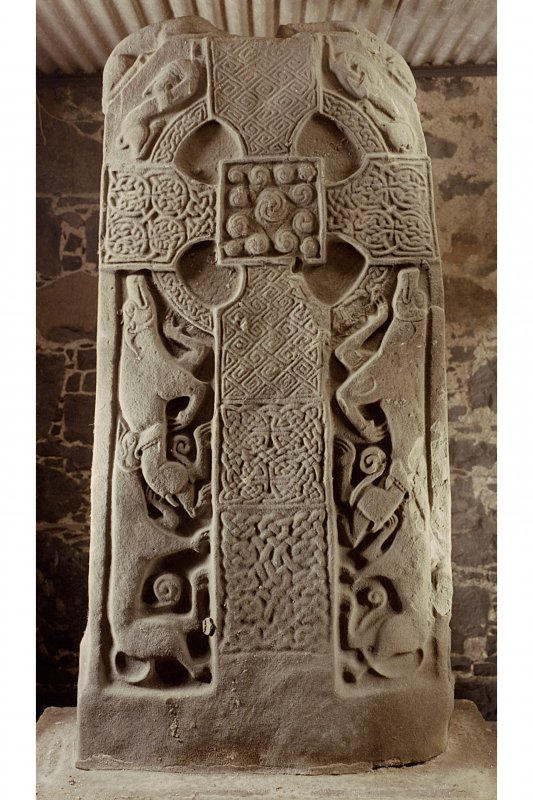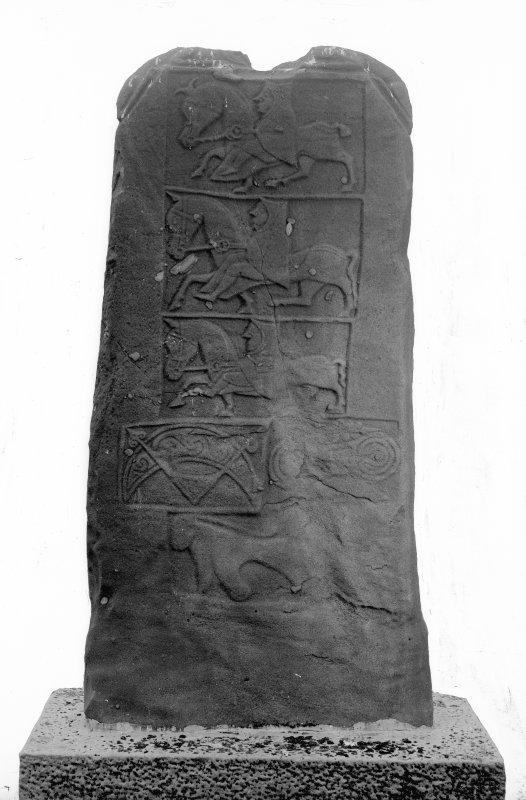Pictish Cross Stone from St Madoes Churchyard, Perthshire, Scotland, 9th Century
 |
 A larger image of the upper 2 Pictish horsemen on the Madoes slab. |
 |
 A larger image of the upper 2 Pictish horsemen on the Madoes slab. |
St Madoes Churchyard, Cross-slab
Stone type: sandstone
Place of discovery: NO 1966 2119
Present location: Perth Museum & Art Gallery.
Evidence for discovery: recorded in the 1830s lying flat in the churchyard at St Madoes by James Skene, and set upright in a new stone base at the instigation of T S Muir in 1853. In the 1920s it was moved, in its base, to stand against the wall beside the church door. In the 1990s it was taken to Perth Museum & Art Gallery.
Present condition: battered and worn but largely intact.
Description
A substantial cross-slab, this stone is carved in relief on both broad faces and along the top face E. Two quadrupeds, identified as lions by Henderson & Henderson (2004, 189), lie along the top of the slab, their back legs and long tails trailing over each corner. Whatever they were guarding between them appears to have been deliberately removed, but it had required a dip in the roll moulding at the top of the upper panel on face C. Except for the animals at the top, the two narrow faces B and D lack ornament. On face A, the entire width of the slab is occupied by a ringed cross with cusped arms and shaft outlined by a roll moulding. There is a square central panel filled with one large and twelve smaller bosses, each of which is carved with a triple spiral. The ring and the side-arms are filled with interlace, while the upper and lower arms contain diagonal key pattern. The lower part of the shaft is divided into two panels, one containing looped interlace forming four circles with two crosses in the voids, and below a panel of knotwork. In the spaces on either side of the upper arm are recumbent animals with their heads turned back to lie across their bodies. Below the side-arms the slab is bordered by a plain flatband moulding, and the panels thus formed on either side of the cross-shaft are carved with similar but not identical scenes of gripping beasts. Set vertically, the upper beast seems to be clawing its way upwards, held back by the beast below whose jaws are clamped tightly round its body. The feet have well-defined claws, the tails end in spirals and the muzzles, ears and eyes are carefully delineated.
Face C is carved with three horsemen and three Pictish symbols, each in its own sunken panel, one above the other except for two symbol panels side by side. The horses and their riders are very similar but not identical, and each faces left. Despite the detailed treatment of reins and circular harness fittings, the proportions of the horses are poorly drawn. The topmost horse has a cropped tail. Each rider is seated on a saddle cloth and is wearing a short hooded cloak, apparently unarmed. There is an unidentifiable object beneath the head of the middle horse. Below the horsemen are two panels defined by roll mouldings, that on the left containing an ornamented crescent and V-rod and that on the right a largely defaced but elaborate double disc and Z-rod. The final panel below contains a lumpish Pictish beast facing left.
Date: ninth century.
Source: Canmore 28201
As the cross of St Madoes belongs to the best period of Celtic sculpture on stone, it is probable that its age lies somewhere between the beginning of the tenth century and the end of the twelfth.
pp. 224-225, "On the Discovery of a Sculptured Stone at St Madoes, With Some Notes On Interlaced Ornament" by J. Romilly Allen